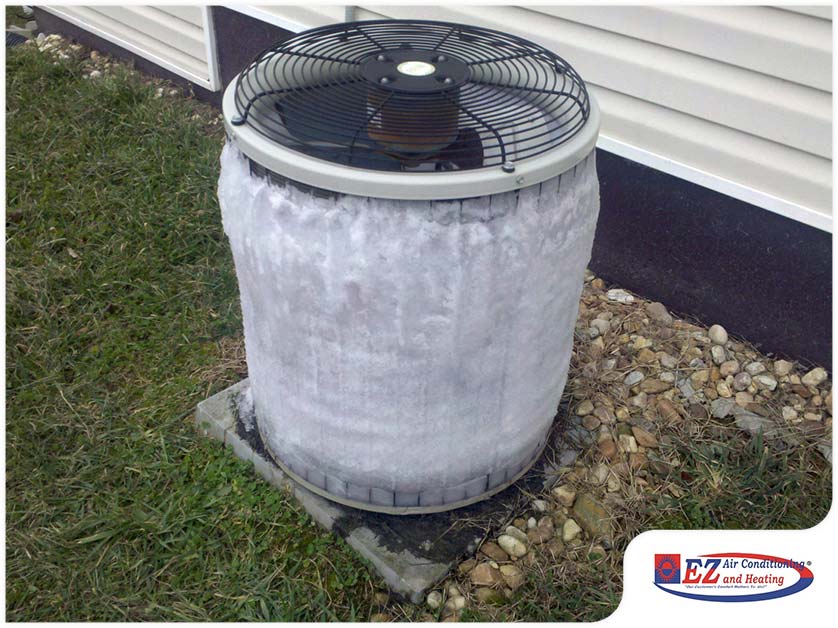A functioning heat pump is essential, especially now that the colder months are here. But like your conventional central air conditioning or ductless HVAC unit, it can suffer issues that may hinder its performance and longevity. One of the most common involves the unit getting iced-up. While it is a normal occurrence, it can be an indication of a bigger problem.

EZ Air Conditioning and Heating, the trusted HVAC contractor in and around San Antonio, TX, explains the causes behind a frozen heat pump, as well as tips on preventing it from happening this winter.
How Ice Accumulation Happens
Unlike a typical furnace that burns fuel to provide heat, your heat pump uses a small amount of energy — mostly electricity — to do its job. The process in which it works is the same as that of air conditioners and refrigerators, but in reverse. The heat pump pulls warm air from the outdoors and transfers it indoors, creating warmth.
As the heat pump performs its function, some of the excess moisture from the air starts building up in the outdoor unit’s coils. Frost then appears as soon as the outdoor temperatures drop. Leaving it unaddressed causes layers of ice to appear, growing larger until the unit itself is covered with it.
Should You Be Worried About an Iced-Up Heat Pump?
Ice buildup on your heat pump’s outdoor unit is often a normal occurrence. This is especially true when temperatures drop significantly in the colder months. When this happens, the heat pump automatically goes in “defrost mode” so it continues to function as intended. This also prevents it from accumulating layers of ice further.
During this cycle, the heat pump starts working in reverse. Once it switches in this mode, the reversing valve starts sending hot refrigerant to the outdoor unit to thaw the frozen coils. The outdoor fan stops working and accelerates the increase in temperature within the coils. The defrost cycle varies depending on the ambient temperature and humidity conditions — it can last between 10 to 15 minutes, or until the coils reach a specific temperature. Once the unit is free of frost, the heating mechanism within the unit will stop, causing it to revert back to heating your home.
When Is It Considered a Problem?
You can rest easy knowing that your heat pump is back to its normal operation after the defrost cycle kicks in. However, there can be times when the unit remains frozen. The top part of the outdoor unit and the inner coils are covered in ice. You may also notice that air isn’t being pulled into the unit’s fins. In any of these situations, it would be in your best interest to bring in an HVAC technician to give your heat pump a closer look. An iced-up heat pump could be a symptom of a much bigger issue that needs immediate attention.
The following are some of the potential reasons behind a frozen heat pump:
- Low refrigerant levels. The refrigerant turns from liquid to gas and vice versa as it moves between the heat pump’s indoor and outdoor units during the heating cycle. Its refrigerant levels, or charge, isn’t supposed to decrease the same way your car uses gas. A leak, unfortunately, may occur, increasing the likelihood of the system freezing over.
- Faulty defrost control board. This component of your heat pump monitors the likelihood of ice forming on the outdoor coils. A malfunction could prevent the heat pump from going to defrost mode, causing the coils to freeze over. It will also force the system to rely on auxiliary heat. This, however, may lead to a significant increase in your energy bill.
- Defective reversing valve. This is another heat pump component that plays a vital role in the unit’s overall process. Its primary function is to change the direction of the refrigerant, allowing the system to switch between heating and cooling modes. A broken reversing valve, however, prevents it from defrosting the coils when they begin to ice up.
- Blockages. The buildup of leaves, shrubs, and other debris close to the coils or fan blades can also lead to a frozen heat pump. These blockages keep the system from absorbing heat, causing its inside parts to accumulate frost or ice.
How to Deal With an Iced-Up Heat Pump
You can prevent your heat pump from freezing by following these tips from your duct cleaning and HVAC maintenance pros:
- Change your air filters. Doing this task helps you stay warm in the winter. It helps your heat pump run as smoothly and efficiently as possible, which, in turn, translates to a lower energy bill. Most HVAC contractors recommend changing your air filters every 90 days. However, this will depend on numerous factors, including the number of pets in your home and the members of your household who have respiratory problems.
- Keep the area around the outdoor unit clear of obstructions. Your heat pump’s outdoor unit must have sufficient clearance to ensure proper ventilation and airflow. Refrain from planting shrubs and other vegetation near the unit. Before the season changes, see to it that the area is free of leaves and other debris. While you are at it, check the coils for dirt and dust. Take the time to clean them so they won’t freeze as outdoor temperatures continue to drop in winter.
- Schedule a tune-up appointment. Investing in regular maintenance is key to a well-functioning heat pump. A professional technician can inspect the indoor and outdoor units thoroughly, taking note of issues that may lead to an iced-up heat pump if left unaddressed. If your contractor offers maintenance agreements, sign up for one. Doing so will help keep your system running smoothly, whether it is in heating or cooling mode.
Contact a Trusted HVAC Technician in San Antonio, TX
EZ Air Conditioning and Heating is familiar with all major makes and models of heat pumps. If yours is already showing signs of aging and deterioration, get in touch with our team of experienced technicians for an inspection. Count on us to deliver an affordable solution to get your comfort system back to proper working order in no time, be it implementing simple repairs to recommending a replacement.
Our heating and cooling experts also specialize in keeping your attic insulated and incorporating essential HVAC equipment into your home automation system. To learn more, give us a call at (210) 429-9186, or fill out our contact form to schedule a consultation.





















